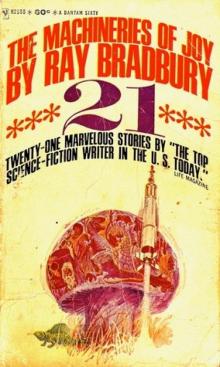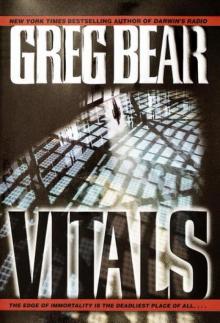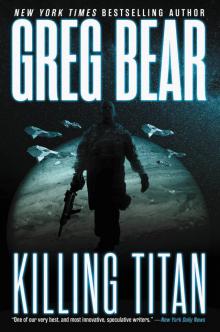Darwin's Children d-2 Read online
Page 24
“I go where the science is,” Dicken said. “I think you’re primed to discover some interesting things. And I think I can help. Besides…” He paused. “They gave you a list. You picked me.”
Jurie lifted one hand dismissively. “Everything we do here is political. I’d be a fool not to recognize it,” he said. “But, frankly, I think we’re winning. Our work is too important to stop, for whatever reason. And we might as well have the best people working with us, whatever their connections. You’re a fine scientist, and that’s the bottom line.” Jurie strolled before a plastic-wrapped greenhouse filled with banana trees, obscured by the translucent plastic. “If you think you’re ready, I have a theoretical problem for you.”
“Ready as I’ll ever be,” Dicken said.
“I’d like for you to start with something a little off the beaten path. Up for it?”
“I’m listening,” Dicken said.
“You can work with Dr. Wrigley’s volunteers. Assemble a staff from our resident postdocs under Dee Dee’s supervision, no more than two to begin with. They’re analyzing ancient promoter regions associated with sexual characteristics, physiological changes in humans possibly induced by retroviral genes.” Jurie swallowed conspicuously. “Viruses have induced changes quite evident in our SHEVA children. Now, I’d like to study more mundane instances in humans. Can you think of the fold of tissue of which I’m suspicious?” Jurie asked.
“Not really,” Dicken said.
“It’s like an alarm mounted on a gate kept closed until maturity. When the gate is breached, that announces a major accomplishment, a crucial change; announces it with a burst of pain and a whole cascade of hormonal events. The hormones generated by this experience appear to activate HERV and other mobile elements, preparing our bodies for a new phase of life. Reproduction is imminent, this breach tells the body. Time to prepare.”
“The female hymen,” Dicken guessed.
“The female hymen,” Jurie said. “Is there any other kind?” He was not being sarcastic. It was a straight question. “Are there other gates to be opened, other signals?… I don’t know. I’d like to know.” Jurie studied Dicken, eyes glittering with enthusiasm once again. “I’m supposing that viruses have altered our phenotype to produce the hymen. Rupturing the hymen gives them warning that sex is taking place, so they can prepare to do all that they do. By altering expression of key genes, promoting or blocking them, the viruses may change our behavior as well. Let’s find out how.” He reached into his jacket pocket, removed a small plastic case, and handed the case to Dicken. “My notes. If you find them useful, I’ll be content.”
“Good,” Dicken said. He knew very little about hymens; he wondered what his other resources would be.
“SHEVA females don’t have hymens, you know,” Jurie said. “No such membranes. Comparison should bring up fascinating divergences in hormonal pathways and viral activations. And viral activations are what concern me.”
Dicken found himself nodding. He was almost hypnotized by the audacity of the hypothesis. It was perverse; it was perversely brilliant. “You think menarche in SHEVA females will switch on viral mutations?” he asked.
“Possibly,” Jurie said evenly, as if discussing the weather. “Interested?”
“I am,” Dicken said after a thoughtful pause.
“Good.” Jurie reached up and pulled his head to one side, making the bones in his neck pop. His eyes turned elsewhere, and he nodded once and walked away, leaving Turner and Dicken alone in the warehouse between the trailers and the gardens.
The interview was over.
Turner escorted Dicken back through the zoo, the foot baths, and the corridors to the steel door. They stopped off at the maintenance office to get the key to Dicken’s dorm room.
“You’ve survived meeting the Old Man,” Turner said, then showed Dicken the way to the dorm wing for new residents. He held up a key, pinched the key’s tag, turning it from blue to red, and dropped it into Dicken’s palm. He stared at Dicken for a long, uncomfortable moment, then said, “Good luck.”
Turner walked back down the hall, shaking his head. Over his shoulder, he called out, “Jesus! Hymens. What next?”
Dicken closed the door to the room and switched on the overhead light. He sat on the narrow, tightly made-up bed, and rubbed his temples and jaw muscles with trembling fingers, dizzy from repressed emotion.
For the first time in his life, the prey Dicken was after was not microbial.
It was a disease, but it was entirely human.
10
ARIZONA
Stella awoke to the sound of an over-under songfest between barracks. The wake-up bell had not yet rung. She rolled between the crisp white sheets of the top bunk and stared up at the ceiling tiles. She was familiar with the routine: A few dozen boys and girls were hanging out of the windows of their barracks, singing to each other across the razor-wire fence. The over was loud and almost tuneless; the under was subtle and not very clear from where she lay. She had no doubt it carried a lot of early-morning gossip, however.
She closed her eyes for a moment and listened. The singers in the barracks tended to slip into harshly sweet and sky-shaking laments, pushing sounds around both sides of their ridged tongues, circulating breath through nose and throat simultaneously. The two streams of song began to play counterpoint, weaving in and out in a way designed to prevent any eavesdropping by the counselors.
Not that the counselors had yet figured out how to interpret underspeech.
Stella heard loud clanging. She closed her eyes and grinned. She could see it all so clearly: Counselors were going through the barracks, banging metal trash-can lids and shouting for the children to shut up. Slowly, the songs scattered like gusts of scented air. Stella imagined the heads withdrawing from the windows, children rushing to their bunks, climbing under their covers.
Tomorrow, other barracks would take their turns. There was a kind of lottery; they tried to predict how long it would take the counselors to get from their compound to the guilty barracks, and how long they could be fooled as to which were the offending barracks. Her barracks might join in and undergo the same trash-can-lid response. Stella would be part of the songfest. She did not look forward to the challenge. She had a high, clear overvoice, but needed work on her underspeech. She was not quite as facile as the others.
Silence returned to the morning. She sank under the covers, waiting for the alarm bell. New uniforms had been deposited at the end of each bunk. The bunks were stacked three high, and the kids began each morning with a shower and a change of clothes, to keep the scent from building on their bodies or what they wore.
Stella knew that her natural smell was not offensive to humans. What concerned the camp counselors and captains was persuasion.
The girls below her, Celia and Mandy, were stirring. Stella preferred to be among the first in the showers. The wake-up bell at the south end of the hall went off as she ran toward the gate to the showers. Her thin white robe flapped at mid-thigh level.
Fresh towels and brushes were provided every day. She took a towel and a toothbrush but avoided using toothpaste. It had a lingering smell that she suspected was meant to confuse. Stella stood at the long basin with the polished steel mirror and ran the moist brush over her teeth, then massaged her gums with one finger, as Mitch had showed her how to do almost ten years ago.
Twenty other girls were already in the shower room, most from other barracks. Stella’s building—barracks number three—tended to be slow. It contained the older girls. They were not as chipper or enthusiastic as the younger girls. They knew all too well what the day had in store—boredom, ritual, frustration. Stagnation.
The youngest girl in the camp was ten. The oldest was fifteen.
Stella Nova was fourteen.
After she finished, Stella returned to her bunk to dress. She looked down the lines of bunks. Most of the girls were still in the showers. It was her day to act as monitor for the barracks. She had to be inconspicu
ous—simply walking from bunk to bunk, bending over, and taking a big whiff would probably land her in detention, with Miss Kantor asking pointed questions. But it had to be done.
Stella carried a stack of school newspapers printed the day before. She walked from bunk to bunk, placing a paper on each bunk and gently sniffing the unmade sheets without bending over.
Within ten minutes, as the girls returned from the showers and began to dress, Stella had a good picture of the health and well-being of the barracks. Later, she would report to her deme mentor. The mentors changed from day to day or week to week. Underspeech or cheek-flashes would tell her who was responsible today. She would make a quick report with underspeech and scenting, before the heavily supervised, once-a-week, coed outdoor activity began.
The girls had thought this procedure up all by themselves. It seemed to work. The bed check was not just useful in knowing how each member was faring, it was also an act of defiance.
Defiance was essential to keeping their sanity.
Perhaps they would have early warning if the humans passed along any more diseases. Perhaps it was just a way of feeling they had some control over their lives. Stella didn’t care.
Catching the scent of her barracks mates was reward enough. It made her feel as if she were a part of something worthwhile, something not human.
11
Americol Research Headquarters
BALTIMORE, MARYLAND
“Elcob hobe!”
Liz Cantrera rushed past Kaye, a rack of clear plastic trays clattering in her arms beneath the flopping edge of a folder clamped between her teeth. She deposited the rack near the safety sink and pulled the black-bound folder from her mouth. “This just in from La Robert.”
Kaye hung her coat on the knobs behind the lab door. “Another salvo?”
“Mm hmm. I think Jackson is jealous you were asked to testify and not he.”
“Nobody should envy me that.” Kaye waggled her fingers. “Give it to me.”
Cantrera smirked and handed her the folder. “He’ll be pushing a disease model long after the Karolinska hangs gold on you.”
Kaye leafed through the fifty-page brief and response to their work of the last two years. This was the big one. Robert Jackson, PI for the larger group and in some respects her boss, was working very hard to get Kaye out of his labs, out of the building, out of the way.
The expected publication date for Jackson’s paper in the Journal of Biologics and Epigenetics was sticky-tabbed to the last page: December. “How nice he’s passed peer review,” Kaye said.
Liz put her hands on her hips and stood in an attitude of defiant expectation. She pushed back a strand of curly strawberry blonde hair and loudly chewed a wad of gum. Her eyes were bright as drops of fresh blue ink. “He says we’re removing necessary transcription factors surrounding our ERV targets, throwing out the baby with the contaminated bathwater.”
“A lot of those factors are transactivated by ERV. You can’t have it both ways, Dr. Jackson. Well, at least we can shoot that one down.” Kaye slumped on a stool. “We’re not getting anywhere,” she muttered. “We’re taking out the viruses and not getting any baby chimps. What does it take for him to come around?” She glanced up at Liz, who was still waggling her hips and snapping her chewing gum in mock defiance of La Robert.
Liz cracked a big sappy smile. “Feel better?”
Kay shook her head and laughed despite herself. “You look like a Broadway gamine. Who are you supposed to be, Bernadette Peters?”
Liz cocked her hips and fluffed her hair with one hand. “She’s a corker. Which play?” she demanded. “Revival of Mame?”
“Sweeney Todd,” Kaye said.
“That would be Winona Ryder,” Liz countered.
Kaye groaned. “Where do you get so much energy?”
“Bitterness. Seriously, how did it go?”
“I’m being used as a prop by one side and a patsy by the other. I feel like Dorothy in the tornado.”
“Sorry,” Liz said.
Kaye stretched and felt her back pop. Mitch used to do that for her. She riffled through Jackson’s folder again and found the page that through instinct, and a touch of luck, had caught her eye a moment before: suspect lab protocols.
As ever, Jackson was trapped in a maze of in vitro studies—test-tube and petri dish blind alleys using Tera2 tumor cell lines—proven traps for making mistakes with ERV. Hell, he’s even using chicken embryos, she thought. Egglayers don’t use ERVs the same way we do.
“Jackson’s vaccines kill monkeys,” Kaye said softly, tapping the page. “Marge doesn’t like projects that never get past animal studies.”
“Shall we play another game of Gotcha with Dr. Jackson?” Liz asked innocently.
“Sure,” Kaye said. “I am almost cheered by this.” She dropped the folder on her small, crowded desk.
“I’m off to check our arrays, and then I’m going home,” Liz called out as she pushed through the door with the tray. “I’ve been working all night. You in for the week?”
“Until they fire me,” Kaye said. She rubbed her nose reflexively. “I need to look over the fragile site studies from last week.”
“Prepped and digitized. They’re on the photobase,” Liz said. “There’s some leftover spaghetti in the fridge.”
“Heavenly,” Kaye said.
“Bye,” Liz called as the door swung closed behind her.
Kaye got up and rubbed her nose again. It felt slightly stuffy, not unpleasantly so. The lab smelled unusually sweet and fresh, not that it ever smelled dirty. Liz was a stickler for cleanliness.
The scent was hard to place, not at all like perfume or flowers.
There was a long day’s work ahead, preparing for tomorrow’s morning meeting. Kaye closed her eyes, hoping to find her calm spot; she needed to focus on the chromosome results from last week. Get the sour clamp of Washington off her gut.
She pulled the stool over to the workstation and entered her password, then called up the tables and photos of chimpanzee chromosome mutations.
Early-stage embryos modified for lab work had had all of their single-copy ERVs deleted, but all multicopy ERVs, LINEs, and “defective” ERVs left intact. They had then been allowed to develop for forty-eight hours. The chromosomes, bunched up by mitosis, were removed, photographed, and crudely sequenced. What Kaye was looking for were anomalies around fragile sites and hot spots in the chromosomes—regions of genes that responded quickly to environmental change, suggesting rapid adaptive response.
The modified chimp chromosomes were severely distorted—she could tell that just by looking at the photos. The fragile sites were all screwed up, broken and rearranged incorrectly. The embryos would never have implanted in the womb, much less gone to term. Even single-copy ERVs were important to fetal development and chromosome adaptation in mammals, perhaps especially so in primates.
She looked over the analysis and saw random and destructive methylation of genes that should be actively transcribing, necessary lengths of DNA mothballed like a fleet of old ships, curling the chromatin into an agony of alternating misplaced activity and dark, inactive lassitude.
They looked ugly, those chromosomes, ugly and unnatural. The early-stage embryos, growing under the tutelage of such chromosomes, would die. That was the story of everything they had done in the lab. If, by rare chance, the ERV-knockout embryos managed to implant and begin development, they were invariably resorbed within the first few weeks. And getting that far had required giving the chimp mothers massive drug regimens developed for human mothers at fertilization clinics to prevent miscarriages.
The ERVs served so many functions in the developing embryos, including mediating tissue differentiation. And it was already obvious that TLV—the Temin-Larsson-Villarreal conjecture—was correct. Highly conserved endogenous retroviruses expressed by the trophectoderm of the developing embryo—the portion that would develop into the surrounding amnion and placenta—protected against attacks by the mothe
r’s immune system. The viral envelope proteins selectively subdued the mother’s immune response to her fetus without weakening the mother’s defenses against external pathogens, an exquisite dance of selectivity.
Because of the protective function of legacy retroviruses, ERV knockout—the removal or stifling of most or all of the genome’s “original sins”—was invariably fatal.
Kaye vividly remembered the chill she had felt when Mitch’s mother had described SHEVA as “original sin.” How long ago had that been—fifteen years? Just after they had conceived Stella.
If SHEVA and other ERV constituted original sin, then it was starting to look as if all placental mammals, perhaps all multicelled life forms, were filled with original sin, required it, died without it.
And wasn’t that what the Garden of Eden was all about? The beginning of sex and self-knowledge and life as we know it.
All because of viruses.
“The hell with that,” Kaye muttered. “We need a new name for these things.”
12
ARIZONA
Roll call was Stella’s least favorite time of day, when the girls were all gathered together and Miss Kantor walked between the rows under the big tent.
Stella sat cross-legged and drew little figures of flowers and birds in the dust with her finger. The canvas flapped with the soft morning breeze. Miss Kantor walked between the lines of seated, cross-legged adolescents and leafed through her daybook. She relied entirely on paper, simply because losing an e-pad or laptop in the reserve was a severe offense, punishable by dismissal.
The dormitories held no phones, no satellite feeds, no radios. Television was limited to educational videos. Stella and most of the other children here had come to abhor television.

 Foundation and Chaos
Foundation and Chaos Halo: Silentium
Halo: Silentium Blood Music
Blood Music Halo: Cryptum
Halo: Cryptum Halo: Primordium
Halo: Primordium The Unfinished Land
The Unfinished Land Hardfought
Hardfought Hull Zero Three
Hull Zero Three Slant
Slant Multiverse: Exploring the Worlds of Poul Anderson
Multiverse: Exploring the Worlds of Poul Anderson Take Back the Sky
Take Back the Sky Nebula Awards Showcase 2015
Nebula Awards Showcase 2015 Machineries Of Joy
Machineries Of Joy A Martian Ricorso
A Martian Ricorso Eternity
Eternity Vitals
Vitals The Infinity Concerto
The Infinity Concerto Beyond the Farthest Suns
Beyond the Farthest Suns Moving Mars
Moving Mars Quantico
Quantico Darwin's Radio
Darwin's Radio Beyond Heaven's River
Beyond Heaven's River Star Wars - Rogue Planet
Star Wars - Rogue Planet Legacy (Eon, 1)
Legacy (Eon, 1) War Dogs: Ares Rising
War Dogs: Ares Rising Sisters
Sisters Dead Lines
Dead Lines Just Over the Horizon (The Complete Short Fiction of Greg Bear Book 1)
Just Over the Horizon (The Complete Short Fiction of Greg Bear Book 1) Eon (Eon, 2)
Eon (Eon, 2) Venging
Venging Eon
Eon City at the End of Time
City at the End of Time Psychlone
Psychlone Dead Lines, A Novel of Life... After Death
Dead Lines, A Novel of Life... After Death Eternity (Eon, 3)
Eternity (Eon, 3) Cryptum
Cryptum Corona
Corona Sleepside: The Collected Fantasies
Sleepside: The Collected Fantasies Women in Deep Time
Women in Deep Time Queen of Angels
Queen of Angels Darwin's Children
Darwin's Children Dinosaur Summer
Dinosaur Summer The Forge of God tfog-1
The Forge of God tfog-1 Foundation and Chaos f-9
Foundation and Chaos f-9 Star Wars: Rogue Planet
Star Wars: Rogue Planet The Forge of God
The Forge of God Mariposa
Mariposa Halo: Cryptum: Book One of the Forerunner Saga
Halo: Cryptum: Book One of the Forerunner Saga Strength of Stones
Strength of Stones Anvil of Stars
Anvil of Stars B00AQUQDQO EBOK
B00AQUQDQO EBOK Anvil of Stars tfog-2
Anvil of Stars tfog-2 Ares Rising 1: War Dogs
Ares Rising 1: War Dogs Rogue Planet (star wars)
Rogue Planet (star wars) The Machineries of Joy
The Machineries of Joy Far Thoughts and Pale Gods
Far Thoughts and Pale Gods Songs of Earth and Power Omnibus
Songs of Earth and Power Omnibus Killing Titan
Killing Titan Darwin's Radio d-1
Darwin's Radio d-1 Darwin's Children d-2
Darwin's Children d-2